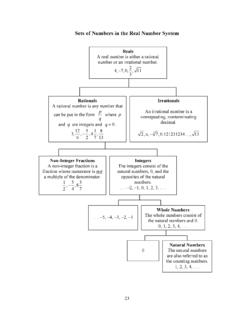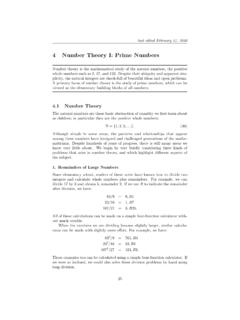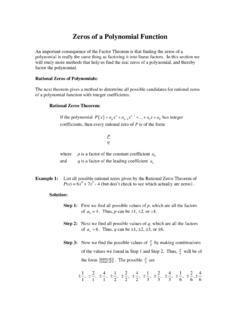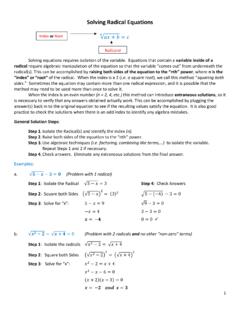Transcription of Crime and Punishment: An Economic Approach
1 This PDF is a selection from an out-of-print volume from the National Bureau of Economic ResearchVolume Title: Essays in the Economics of Crime and PunishmentVolume Author/Editor: Gary S. Becker and William M. Landes, Publisher: NBERV olume ISBN: 0-87014-263-1 Volume URL: Date: 1974 Chapter Title: Crime and Punishment: An Economic ApproachChapter Author: Gary S. BeckerChapter URL: pages in book: (p. 1 - 54)Since the turn of the century, legislation in Western countries has ex-panded rapidly to reverse the brief dominance of laissez faire during thenineteenth century.
2 The state no longer merely protects against viola-tions of person and property through murder, rape, or burglary but alsorestricts "discrimination" against certain minorities, collusive businessarrangements, "jaywalking," travel, the materials used in construction,and thousands of other activities. The activities restricted not only arenumerous but also range widely, affecting persons in very different pur-suits and of diverse social backgrounds, education levels, ages, races, , the likelihood that an offender will be discovered and con-Iwould like to thank the Lilly Endowment for financing a very productive summer in1965 at the University of California at Los Angeles.
3 While there I received very helpfulcomments on an earlier draft from, among others, Armen Alchian, Roland McKean, HaroldDemsetz, Jack Hirshliefer, William Meckling, Gordon Tullock, and Oliver have also benefited from comments received at seminars at the University of Chicago,Hebrew University, RAND Corporation, and several times at the Labor Workshop ofColumbia; assistance and suggestions from Isaac Ehrlich and Robert Michael; and sugges-tions from the editor of the Jour,wlof PoliticalEconomy,RobertA. and Punishment: An Economic ApproachUniversityof Chicago and National Bureau of Economic ResearchGary S.
4 Becker1. INTRODUCTION2 Crime AND Punishment: AN Economic Approach victed and the nature and extent of punishments differ greatly from personto person and activity to activity. Yet, in spite of such diversity, somecommon properties are shared by practically all legislation, and theseproperties form the subject matter of this the first place, obedience to law is not taken for granted, andpublic and private resources are generally spent in order both to preventoffenses and to apprehend offenders. In the second place, conviction is notgenerally considered sufficient punishment in itself; additional and some-times severe punishments are meted out to those convicted.
5 What deter-mines the amount and type of resources and punishments used to enforcea piece of legislation? In particular, why does enforcement differ sogreatly among different kinds of legislation?The main purpose of this essay is to answer normative versions ofthese questions, namely, how many resources and how much punish-ment shouldbeused to enforce different kinds of legislation? Putequivalently, although more strangely, how many offenses shouldbeper-mitted and how many offenders shouldgounpunished? The method usedformulates a measure of the social loss from offenses and finds those ex-penditures of resources and punishments that minimize this loss.
6 Thegeneral criterion of social loss is shown to incorporate as special cases,valid under special assumptions, the criteria of vengeance, deterrence,compensation, andrehabilitationthathistorically have figuredsoprominently in practice and criminological optimal amount of enforcement is shown to depend on, amongother things, the cost of catching and convicting offenders, the nature ofpunishments for example, whether they are fines or prison terms andthe responses of offenders to changes in enforcement. The discussion,therefore, inevitably enters into issues in penology and theories ofcriminal behavior.
7 A second, although because of lack of space subsidiary,aim of this essay is to see what insights into these questions are providedby our " Economic " Approach . It is suggested, for example, that a usefultheory of criminal behavior can dispense with special theories of anomie,psychological inadequacies, or inheritance of special traits and simplyextend the economist's usual analysis of BASIC ANALYSISA. THE COST OF CRIMEA lthough the word " Crime " is used in the title to minimize terminologi-cal innovations, the analysis is intended to be sufficiently general to coverCrimes against persontCrimes against propertIllegal goods andSome other crimesTotalPublic expenditures onCorrectionsSome private costs ofOverall totalSOURCE.
8 Presidetall violations, not jusreceive so much new:white-collar crimes,broadly, " Crime " isnotwithstanding theevidence recently puEnforcement and Adireproduced in Tableand local levels on poamounted to over $'guards, counsel, andlion. Unquestionablysignificantly understathe course of enforciiI. This neglect probatmerit any systematic scieianalysis is seen most clearlgambling is an "economictrue that this loss of probathe excitement of gamblinpleasures of gambling areare likely to engender a rfor the higher and moreAppendix).GARY from personch diversity, someslation, and thesen for granted, andder both to preventconviction is notand some-What deter-used to enforce'orcement differ sormative versions ofhow much punish-of legislation?
9 Putshouldbeper-The method usedand finds those ex-mize this loss. Thekte as special cases,deterrence,have figuredsodepend on, amongpders, the nature ofterms andfit. The discussion,and theories ofspace subsidiary,are providedthat a usefulof anomie,11traits and simplyimize terminologi-tly general to coverTABLE 1 Economic COSTS OF CRIMESTypeCosts(Millions of Dollars)Crimes against persons815 Crimes against property3,932 Illegal goods and services8,075 Some other crimes2,036 Total14,858 Public expenditures on police, prosecution,and courts3,178 Corrections1,034 Some private costs of combating crimeI ,9 10 Overall total20,980 SouRcE.
10 President's Commission (1967d, p. 44).all violations, not just felonies likemurder, robbery, and assault, whichreceive so much newspaper coverage but also tax evasion, the so-calledwhite-collar crimes, and traffic and other violations. Looked at thisbroadly, " Crime " is an economically important activity or "industry,"notwithstanding the almost total neglect by Some relevantevidence recently put together by the President's Commission on LawEnforcement and Administration of Justice (the " Crime Commission") isreproduced in Table 1. Public expenditures in 1965 at the federal, state,and local levels on police, criminal courts and counsel, and "corrections"amounted to over $4 billion, while private outlays on burglar alarms,guards, counsel, and some other forms of protection were about $2 bi!
















